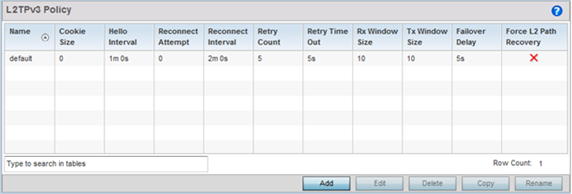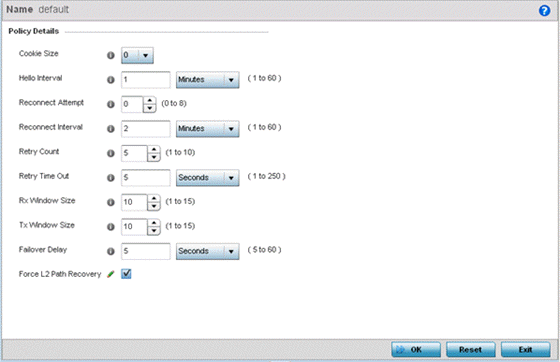L2TP V3 is an IETF standard used for transporting different types of layer 2 frames in an IP network. L2TP V3 defines control and encapsulation protocols for tunneling layer 2 frames between two IP nodes.
Use L2TP V3 to create tunnels for transporting layer 2 frames. L2TP V3 enables WiNG supported controllers and access points to create tunnels for transporting Ethernet frames to and from bridge VLANs and physical ports. L2TP V3 tunnels can be defined between WiNG managed devices and other vendor devices supporting the L2TP V3 protocol.

Note
A pseudowire is an emulation of a layer 2 point-to-point connection over a PSN (packet-switching network). A pseudowire was developed out of the necessity to encapsulate and tunnel layer 2 protocols across a layer 3 network.Ethernet VLAN pseudowires transport Ethernet frames to and from a specified VLAN. One or more L2TP V3 tunnels can be defined between tunnel end points. Each tunnel can have one or more L2TP V3 sessions. Each tunnel session corresponds to one pseudowire. An L2TP V3 control connection (a L2TP V3 tunnel) needs to be established between the tunneling entities before creating a session.
For optimal pseudowire operation, both the L2TP V3 session originator and responder need to know the psuedowire type and identifier. These two parameters are communicated during L2TP V3 session establishment. An L2TP V3 session created within an L2TP V3 connection also specifies multiplexing parameters for identifying a pseudowire type and ID.

Note
If connecting an Ethernet port to another Ethernet port, the pseudowire type must be Ethernet port, if connecting an Ethernet VLAN to another Ethernet VLAN, the pseudowire type must be Ethernet VLAN.To define an L2TP V3 tunnel configuration:

| Name | Lists the 31 character maximum name assigned to each listed L2TP V3 policy upon creation. |
| Cookie size | Displays the size of each policy's cookie field within each L2TP V3 data packet. L2TP V3 data packets contain a session cookie which identifies the session (pseudowire) corresponding to it. If using the CLI, the cookie size can't be configured per session, and are the same size for all sessions with in a tunnel. |
| Hello Interval | Displays each policy‘s interval between L2TP V3 hello keep alive messages exchanged within the L2TP V3 connection. |
| Reconnect Attempts | Lists each policy‘s maximum number of re-connection attempts to reestablish a tunnel between peers. |
| Reconnect Interval | Displays the duration set for each listed policy between two successive reconnection attempts. |
| Retry Count | Lists the number of retransmission attempts set for each listed policy before a target tunnel peer is defined as not reachable. |
| Retry Time Out | Lists the interval the interval (in seconds) set for each listed policy before the retransmission of a L2TP V3 signaling message. |
| Rx Window Size | Displays the number of packets that can be received without sending an acknowledgement. |
| Tx Window Size | Displays the number of packets that can be transmitted without receiving an acknowledgement. |
| Failover Delay | Lists the time (in either seconds or minutes) for establishing a tunnel after a failover (VRRP/RF Domain/Cluster). |
| Force L2 Path Recovery | Lists whether force L2 path recovery is enabled (as defined by a green checkmark) or disabled (as defined by a red X). Once a tunnel is established, enabling this setting forces server and gateway learning behind the L2TPv3 tunnel. |

| Cookie size | L2TP V3 data packets contain a session cookie which identifies the session (pseudowire) corresponding to it. Use the spinner control to set the size of the cookie field present within each L2TP V3 data packet. Options include 0, 4 and 8. The default setting is 0. If using the CLI, the cookie size can't be configured per session, and are the same size for all sessions with in a tunnel. |
| Hello Interval | Define an interval in Seconds (1 - 3,600), Minutes (1 -60) or Hours (1) between L2TP V3 hello keep alive messages exchanged within the L2TP V3 control connection. The default setting is 1 minute. |
| Reconnect Attempts | Use the spinner control to set a value (from 0 - 250) representing the maximum number of reconnection attempts to reestablish the tunnel. The default interval is 0. |
| Reconnect Interval | Define an interval in either Seconds (1 - 3,600), Minutes (1 -60) or Hours (1) between two successive reconnection attempts. The default setting is 2 minutes. |
| Retry Count | Use the spinner control to define how many retransmission attempts are made before determining a target tunnel peer is not reachable. The available range is from 1 - 10, with a default value of 5. |
| Retry Time Out | Use the spinner control to set the interval (in seconds) before initiating the retransmission of a L2TP V3 signaling message. The range is from 1 - 250, with a default of 5. |
| Rx Window Size | Specify the number of packets received without sending an acknowledgment. The range is from 1 - 15, with a default of 10. |
| Tx Window Size | Specify the number of packets transmitted without receiving an acknowledgment. The range is from 1 - 15, with a default of 10. |
| Failover Delay | Set the time in Seconds (5 - 60) or Minutes (1) for establishing a tunnel after a failover (VRRP/RF Domain/Cluster). The default is 5 seconds |
| Force L2 Path Recovery | Determine whether force L2 path recovery is enabled or disabled. Once a tunnel is established, enabling this setting forces server and gateway learning behind the L2TPv3 tunnel. The default setting is disabled. |